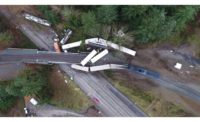Under new Federal Railroad Administration directives, Amtrak is making safety improvements on its Northeast Corridor line, including expanding its use of technology to control train speeds.
The orders, which FRA announced on May 16, came four days after Amtrak train No. 188 derailed in Philadelphia, killing eight passengers and injuring scores of others.
According to the National Transportation Safety Board, which is investigating the accident, northbound train No. 188 was running at 102 miles per hour—more than double the speed limit—when it ran off the tracks in a curve at Frankford Junction, northeast of Center City, Philadelphia.
FRA required Amtrak to widen its use of automatic train control (ATC) around the crash site. ATC sends a signal to the engineer if the system detects that a train is exceeding the speed limit. If the engineer doesn’t slow the train, the system automatically applies the brakes, FRA said.
ATC has been in use for more than 20 years for southbound trains at and near the derailment site. The FRA ordered Amtrak to install the technology to alert northbound trains, too.
Amtrak in a May 16 blog post said it had completed, over the May 16-17 weekend, installation of an ATC system "code-change point" west of the Frankford Junction curve to alert northbound train engineers about excessive speed and, if needed, activate the brake system.
The railroad said a code-change point had been in place on the east side of the Frankford Junction curve since 1990, because southbound trains approaching the curve had to slow greatly, to 50 mph from 110 mph.
Amtrak added, "A similar point was not installed on the west side of the curve because the maximum speeds were so much lower that a train that did not slow could still round the curve without derailing." Northbound trains entering the curve had to slow to 50 mph from 80 mph in the curve.
After the railroad worked to repair its infrastructure at the derailment site, it restored its service between Philadelphia and New York City during the morning of May 18, Amtrak said on Twitter. Service had been suspended since the derailment.
Amtrak President and CEO Joseph Boardman in a May 17 statement added, "Our repairs have been made with the utmost care and emphasis on safety, including complete compliance with Federal Railroad Administration directives."
Besides the speed-control mandate, FRA instructed Amtrak to assess risks on all its Northeast Corridor curves and implement “appropriate technology” to prevent speed-related derailments. The railroad also is to “take a new look at all curves along the corridor and determine what more can be done to improve safety in any of these areas,” FRA said.
Moreover, FRA ordered Amtrak to install more wayside speed-limit signs.
Acting FRA Administrator Sarah Feinberg said in a statement: “These are just initial steps, but we believe they will immediately improve safety on the Northeast Corridor.”
Feinberg added, “Full implementation of positive train control [PTC] is the most important step that must be taken to improve safety.”
Amtrak has fully implemented PTC, a different technology than ATC, on 205 miles of its 457-mile-long Boston-to-Washington, D.C., corridor, including 48.5 miles between New York City and Washington. It is not yet fully operational in the Philadelphia area, however.
Boardman has pledged to have PTC running on the entire Northeast Corridor by Dec. 31, the congressionally mandated PTC deadline for all U.S. passenger-rail main lines and freight routes that carry hazardous substances.



Post a comment to this article
Report Abusive Comment